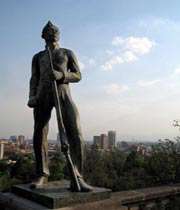This Day in History:
Los Ni?os Héroes Die Defending Mexico City"s Chapultepec Castle (1847)
Los Ninos Héroes (the "Boy Heroes" or "Heroic Cadets") were six teenage military cadets who died defending Mexico at Mexico City"s Chapultepec Castle (then serving as the Mexican army"s military academy) from invading U.S. forces in the 13 September 1847 Battle of Chapultepec.
Their commanders, General Nicol?s Bravo and General José Mariano Monterde, had ordered them to fall back from Chapultepec but the cadets did not; instead, they resisted the invaders until they were killed, with accounts maintaining that the last survivor leapt from Chapultepec Castle wrapped in the Mexican flag to prevent it from being taken by the enemy.
The cadets are honored by an imposing monument at the entrance to Chapultepec Park; and the name Ni?os Héroes, along with the cadets" individual names, are commonly given to streets, squares and schools across the country. For many years they appeared on the MXP $5000 banknote, and they currently appear on the MXN $50 coin. Metro Ni?os Héroes the Mexico City Metro is also named after them.
Chapultepec Castle and the Monument to the six Heroic CadetsThe Ni?os Héroes were:
Juan de la Barrera
Juan Escutia
Francisco M?rquez
Agust?n Melgar
Fernando Montes de Oca
Vicente Su?rez
Juan de la Barrera was born in Mexico City in 1828, the son of Ignacio Mario de la Barrera, an army general, and Juana Inz?rruaga. He enlisted at the age of 12 and was admitted to the Academy on 18 November 1843. During the attack on Chapultepec he was a lieutenant in the military engineers (sappers) and died defending a gun battery at the entrance to the park. Aged 19, he was the oldest of the six.
Juan Escutia was born in Tepic (today"s capital of the state of Nayarit) at some time between 1828 and 1832. Records show he was admitted to the Academy as a cadet on 8 September 1847, but his other papers were lost during the assault. He is believed to have been a second lieutenant in an artillery company. this cadet wrapped himself up in the flag and committed suicide, jumping from the roof to keep it from falling into enemy hands. His body was found on the east flank of the hill, alongside that of Francisco M?rquez. A large mural above the stairway depicts his jump from the roof with the Mexican flag.
Francisco M?rquez was born in Guadalajara, Jalisco, in 1834. Following the death of his father, his mother, Micaela Paniagua, had remarried one Francisco Ortiz, a cavalry captain. He applied to the Academy on 14 January 1847 and, at the time of the battle, belonged to the first company of cadets. A note included in his personnel record says his bullet-riddled body was found on the east flank of the hill, alongside that of Juan Escutia. He was the youngest of the six.

Agust?n Melgar was a native of Chihuahua, Chihuahua, born there at some time between 1828 and 1832. He was the son of Esteban Melgar, a lieutenant colonel in the army, and Mar?a de la Luz Sevilla, both of whom died while he was still young, leaving him the ward of his older sister. He applied to the Academy on 4 November 1846. He was expelled for missing a review on 4 May 1847 but was re-admitted on 8 September. A note in his personnel record explains that after finding himself alone, he tried to stop the enemy on the north side of the castle. He was able to shoot and kill one of the invaders before taking refuge behind some mattresses in one of the rooms. Grievously wounded, his comrades placed him on a table, alongside which his lifeless body was found on 15 September, after the castle had fallen.
Statue dedicated to one of the boy soldiers, along a walkway at the top of Chapultepec CastleFernando Montes de Oca was born in Azcapotzalco, then a town just to the north of Mexico City and nowadays one of the boroughs of the Federal District, between 1828 and 1832. His parents were José Mar?a Montes de Oca and Josefa Rodr?guez. He had applied to the Academy on 24 January 1847, and was one of the cadets who remained in the castle despite the recommendation of General José Mariano Monterde that they return to their homes. His personnel record reads: "Killed for his country on 13 September 1847."
Vicente Su?rez was born in 1833 in Puebla, Puebla. He was the son of Miguel Su?rez, a cavalry officer, and Mar?a de la Luz Ortega. He applied for admission to the Academy on 21 October 1845. A note in his record reads: "Killed defending his country at his sentry post on 13 September 1847. He ordered the attackers to stop, but they continued to advance. He shot one and stabbed another in the stomach with his bayonet, and was killed at his post in hand-to-hand combat. He was killed for his bravery, because his youthfulness made the attackers hesitate, until he attacked them."
The bodies of the six youths were buried in the grounds of Chapultepec Park, in an uncertain location. In 1947 their remains were found and identified and, on 27 September 1952, were re-interred at the Monument to the Heroic Cadets in Chapultepec.
Source: encyclopedia.thefreedictionary.com
Other Links:
The Day in History: Iroquois Confederacy Is Formed (1142)
The Day in History: Maiden Flight of the First US Airship (1923)
The Day in History: Leon Czolgosz Assassinates William McKinley (1901)